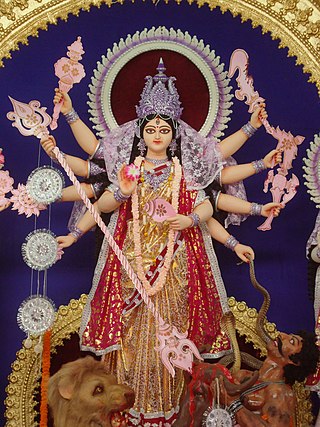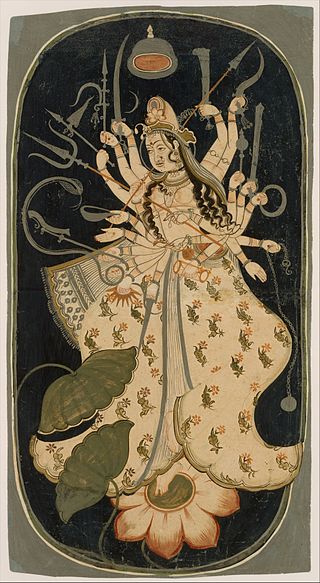
A goddess is a female deity. In many known cultures, goddesses are often linked with literal or metaphorical pregnancy or imagined feminine roles associated with how women and girls are perceived or expected to behave. This includes themes of spinning, weaving, beauty, love, sexuality, motherhood, domesticity, creativity, and fertility. Many major goddesses are also associated with magic, war, strategy, hunting, farming, wisdom, fate, earth, sky, power, laws, justice, and more. Some themes, such as discord or disease, which are considered negative within their cultural contexts also are found associated with some goddesses. There are as many differently described and understood goddesses as there are male, shapeshifting, or neuter gods.

The Trimurti is the trinity of supreme divinity in Hinduism, in which the cosmic functions of creation, preservation, and destruction are personified as a triad of deities. Typically, the designations are that of Brahma the creator, Vishnu the preserver, and Shiva the destroyer. The Om symbol of Hinduism is considered to have an allusion to Trimurti, where the A, U, and M phonemes of the word are considered to indicate creation, preservation and destruction, adding up to represent Brahman. The Tridevi is the trinity of goddess consorts for the Trimurti.

Hindu mythology is the body of myths attributed to, and espoused by, the adherents of the Hindu religion, found in Sanskrit texts such as the Vedic literature, epics like Mahabharata and Ramayana, the Puranas, and mythological stories specific to a particular ethnolinguistic group like the Tamil Periya Puranam and Divya Prabandham, and the Mangal Kavya of Bengal. Hindu myths are also found in widely translated popular texts such as the fables of the Panchatantra and the Hitopadesha, as well as in Southeast Asian texts.
Bhakti yoga, also called Bhakti marga, is a spiritual path or spiritual practice within Hinduism focused on loving devotion towards any personal deity. It is one of the three classical paths in Hinduism which lead to Moksha, the other paths being Jnana yoga and Karma yoga.

Shaktism is one of the several major Hindu denominations wherein the metaphysical reality, or the godhead, is considered metaphorically to be a woman.

Ushas is a Vedic goddess of dawn in Hinduism. She repeatedly appears in the Rigvedic hymns, states David Kinsley, where she is "consistently identified with dawn, revealing herself with the daily coming of light to the world, driving away oppressive darkness, chasing away evil demons, rousing all life, setting all things in motion, sending everyone off to do their duties". She is the life of all living creatures, the impeller of action and breath, the foe of chaos and confusion, the auspicious arouser of cosmic and moral order called the Ṛta in Hinduism.
Hindu texts present diverse views on the position of women, ranging from feminine leadership as the highest goddess, to limiting gender roles. The Devi Sukta hymn of Rigveda, a scripture of Hinduism, declares the feminine energy as the essence of the universe, the one who creates all matter and consciousness, the eternal and infinite, the metaphysical and empirical reality (Brahman), the soul, of everything. The woman is celebrated as the most powerful and the empowering force in some Hindu Upanishads, Sastras and Puranas, particularly the Devi Upanishad, Devi Mahatmya and Devi-Bhagavata Purana.

Tripura Sundari, also known as Rajarajeshvari, Shodashi, Kamakshi, and Lalita is a Hindu goddess, revered primarily within the Shaktism tradition and recognized as one of the ten Mahavidyas. She embodies the essence of the supreme goddess Mahadevi. Central to the Shakta texts, she is widely praised in the Lalita Sahasranama and Saundarya Lahari. In the Lalitopakhyana of the Brahmanda Purana, she is referred to as Adi Parashakti.
The gender of God can be viewed as a literal or as an allegorical aspect of a deity.
The following list consists of notable concepts that are derived from Hindu culture and associated cultures’ traditions, which are expressed as words in Sanskrit or other Indic languages and Dravidian languages. The main purpose of this list is to disambiguate multiple spellings, to make note of spellings no longer in use for these concepts, to define the concept in one or two lines, to make it easy for one to find and pin down specific concepts, and to provide a guide to unique concepts of Hinduism all in one place.

The Brahmavaivarta Purana is a voluminous Sanskrit text and a major Purana (Maha-purana) of Hinduism. It is an important Vaishnava text. This Purana majorly centers around the Hindu deities Radha and Krishna.

In Hinduism, the concept of God varies in its diverse religio-philosophical traditions. Hinduism comprises a wide range of beliefs about God and Divinity, such as henotheism, monotheism, polytheism, panentheism, pantheism, pandeism, monism, agnosticism, atheism, and nontheism.

The Devi Bhagavata Purana, also known as the Srimad Devi Bhagavatam, Srimad Bhagavatam, Bhagavata Purana or simply Devi Bhagavatam, is one of the eighteen Mahapuranas of Hinduism. Composed in Sanskrit by Veda Vyasa, the text is considered a major purana for Devi worshippers (Shaktas). It promotes bhakti (devotion) towards Mahadevi, integrating themes from the Shaktadvaitavada tradition. While this is generally regarded as a Shakta Purana, some scholars such as Dowson have also interpreted this Purana as a Shaiva Purana.
The roots of Shaktism – a Hindu denomination that focuses worship upon Shakti or Devi, the Hindu Divine Mother – penetrate deeply into India's prehistory. The Devi's earliest known appearance in Indian Paleolithic settlements is believed to go back more than 8000 years ago. The Badrinath Monastery, dated to about 7000 years ago, and its associated ritual site of Adi Shankara have been well studied.

Devī is the Sanskrit word for 'goddess'; the masculine form is deva. Devi and deva mean 'heavenly, divine, anything of excellence', and are also gender-specific terms for a deity in Hinduism.

Shakti is the fundamental cosmic energy and a central deity within Shaktism, a significant theological tradition of Hinduism. Representing dynamic forces that permeate the universe, Shakti embodies feminine energy and is often depicted as the consort of Shiva. In this tradition, Devi, the Goddess, is regarded as the Supreme Brahman herself, with all other divine forms seen as her manifestations. The worship of Shakti entails a diverse array of goddesses, including Durga, Kali, Parvati, and Tripura Sundari, each representing unique facets of her power.

Mahadevi, also referred to as Adi Parashakti, Adi Shakti, Mahamaya and Devi, is the supreme goddess in the Shaktism sect of Hinduism. According to this tradition, all Hindu gods and goddesses are considered to be manifestations of this single great Goddess, who is comparable to the deities Shiva and Vishnu as Para Brahman. Shaktas often refer to her as Durga, also believing her to have many other forms such as Tripura Sundari, Bhuvaneshvari, Kali, Parvati, Navadurga, Mahavidya, Lakshmi, Saraswati, and others. Author Helen T. Boursier says: "In Hindu philosophy, both Lakshmi and Parvati are identified as part manifestations of the great goddess—Mahadevi—and the Shakti or divine power".

The Sita Upanishad is a medieval era Sanskrit text and a minor Upanishad of Hinduism. It is attached to the Atharva Veda, and is one of the Vaishnava upanishads. It is categorized as a late Upanishad, in which goddess Sita is extolled as the Ultimate Reality of the Universe (Brahman), the ground of Being (Spirituality), and material cause behind all manifestation. The Upanishad identifies Sita with primordial Prakriti (nature) and her three powers, asserts the text, are manifested in daily life as will (iccha), action (kriyā) and knowledge (jnana).

The Devi Upanishad, is one of the minor Upanishads of Hinduism and a text composed in Sanskrit. It is one of the 19 Upanishads attached to the Atharvaveda, and is classified as one of the eight Shakta Upanishads. It is, as an Upanishad, a part of the corpus of Vedanta literature collection that present the philosophical concepts of Hinduism.



















